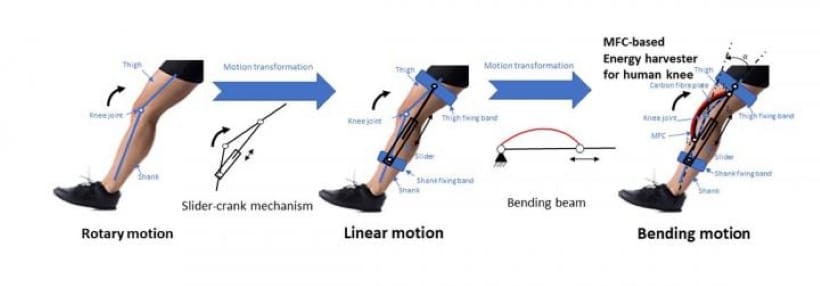
Described by the team in Applied Physics Letters, the energy harvester is attached to the wearer's knee and can generate 1.6 microwatts of power while the wearer walks without any increase in effort. The energy is enough to power devices like health monitoring equipment and GPS devices.
"Self-powered GPS devices will attract the attention of climbers and mountaineers," said author Wei-Hsin Liao, a professor in the department of mechanical and automation engineering.
The researchers are said to have used a special smart macrofibre material, which generates energy from any sort of bending it experiences, to create a slider-crank mechanism. The authors chose to attach the device to the knee due to the knee joint's large range of motion, compared to most other human joints.
"These harvesters can harvest energy directly from large deformations," Liao said in a statement.
Due to the continuous back-and-forth the material will encounter when the wearer walks, every time the knee flexes, the device bends and generates electricity. This means the harvester can "capture biomechanical energy through the natural motion of the human knee," said Liao.
Previous wearable energy harvesters took advantage of the vibration caused in the device as a result of motion, which comes with drawbacks regarding efficiency.
"The frequency of human walking is quite slow, which significantly decreases the energy-harvesting capability," Liao said. Because the group's device uses a different method, it bypasses this limitation.
The prototype weighs 307g and was tested on human subjects walking at speeds from 2 to 6.5kmh (about 1 to 4mph). The researchers compared the wearers' breathing patterns with and without the device and determined that the energy required to walk was unchanged, meaning that the device is generating power at no cost to the human.
The researchers note the advantages of an efficient, wearable energy harvester and look towards future commercialisation of the technology.
"Self-powered equipment can enable users to get rid of the inconvenient daily charge," Liao said. "This energy harvester would promote the development of self-powered wearable devices."




JLR teams with Allye Energy on portable battery storage
This illustrates the lengths required to operate electric vehicles in some circumstances. It is just as well few electric Range Rovers will go off...